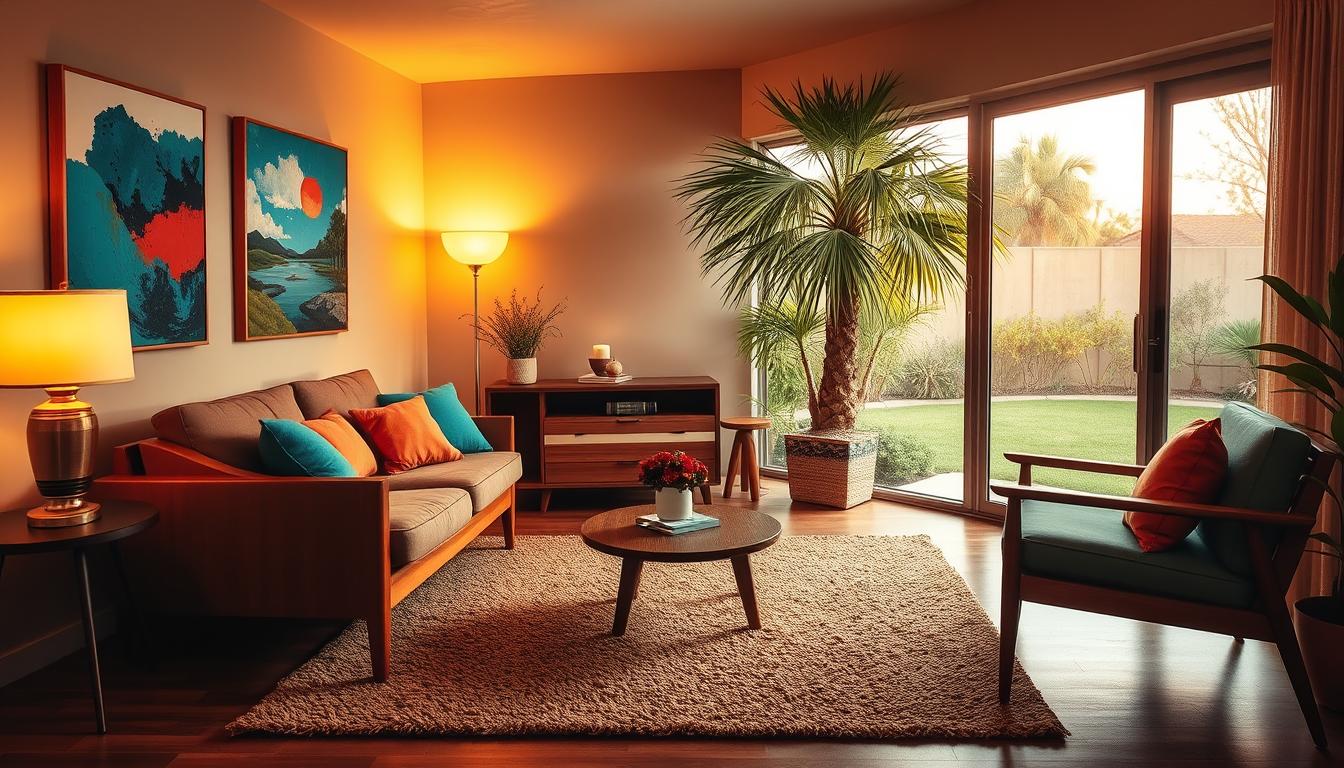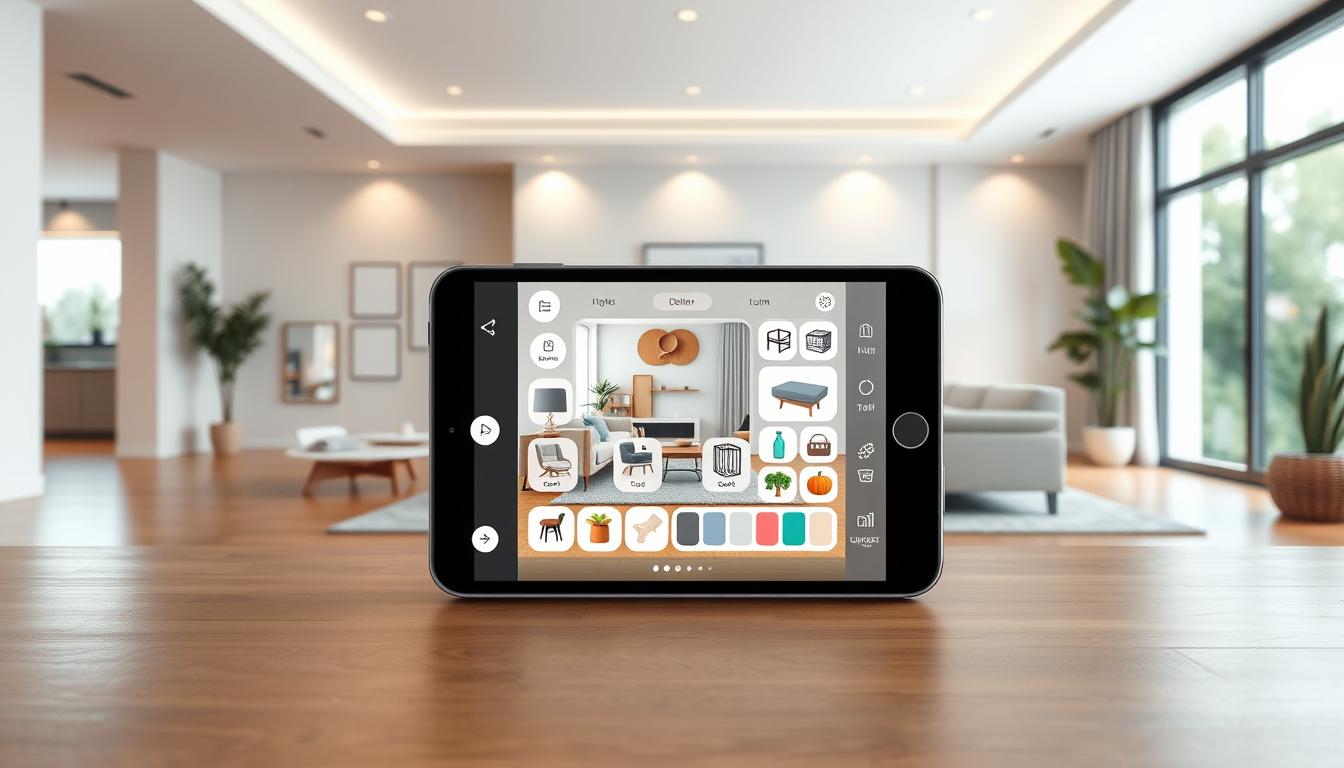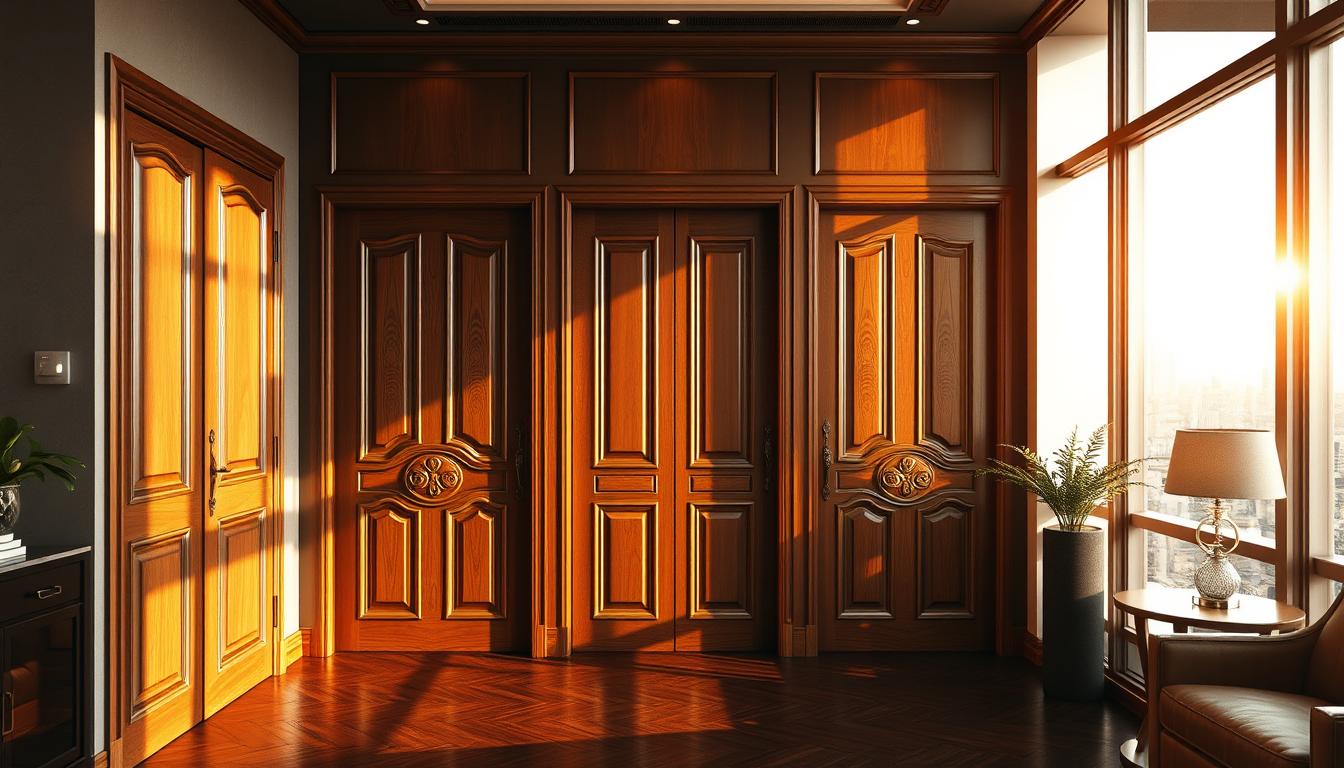The 1950s was a time of big change in home decor. It saw a return to home life and a love for the new. You’ll learn how to add a bit of old-time charm to your home today.
Retro design is all about bright colors, shapes, and being useful. This guide will show you the main parts of 1950s style. We’ll cover furniture and colors that were big back then.
Key Takeaways
- Discover the iconic furniture styles of the 1950s
- Learn how to incorporate retro color trends into your decor
- Explore the importance of geometric patterns in 1950s design
- Understand how to balance nostalgic elements with modern decor
- Get tips on recreating the 1950s look in your own home
The Allure of 1950s Home Design
The 1950s saw a big change in home design, thanks to the post-war boom and modernism. This time was all about mixing function and beauty, shaped by the new generation’s dreams.
Key Features that Define the Era
The 1950s homes were known for their mid-century modern style. This style was all about being simple, useful, and connected to nature.
- Clean lines and minimal ornamentation
- An emphasis on functionality and simplicity
- The use of new materials and technologies
- A focus on indoor-outdoor living
The Impact of Post-War Society on Design
The post-war world changed home design a lot. More people wanted homes, and new building tech came out. The atomic age style also played a big role, with its futuristic vibe.
Suburban living and the growing middle class made homes more popular. Designers made furniture and decor that was modern but affordable for everyone.
Distinctive Color Palettes
The 1950s were famous for their pastel hues and bold contrasts. These colors were used in everything from furniture to wallpaper.
- Pastel colors such as pale pink, baby blue, and mint green
- Bold and bright colors like red, turquoise, and yellow
- Neutral tones like beige, gray, and taupe
These colors showed the era’s optimism and fun. They really shaped the look of 1950s homes.
Iconic Furniture Styles of the 1950s
The 1950s brought a mix of function and beauty to furniture design. This decade saw a big move towards modern styles. Designers focused on simple lines, natural shapes, and new materials.
Mid-Century Modern Influences
Mid-century modern furniture was a big deal in the 1950s. It’s all about being useful, simple, and blending with nature. Key characteristics include:
- Clean lines and minimal ornamentation
- Organic and geometric shapes
- Use of new materials and technologies
- Integration with indoor and outdoor spaces
Designers like Charles and Ray Eames and Knoll furniture company were key. Their work showed the era’s design spirit and inspired future designers.
The Role of Eames and Knoll
Charles and Ray Eames made mid-century modern famous with their designs. Their Eames Lounge Chair and Ottoman showed how to mix function and beauty.
Knoll, led by Florence Knoll, also made iconic furniture. Their pieces were known for sleek lines, simplicity, and top-notch materials.
Popular Materials and Fabrics
The 1950s introduced new materials and fabrics that defined furniture design. Some of the popular materials included:
- Plywood, molded to create complex shapes
- Aluminum, used for its lightweight and durable properties
- Fiberglass, which allowed for innovative chair designs
- Vinyl and leather upholstery, offering a range of textures and durability
These materials, along with the era’s design ideas, made 1950s furniture unique. Knowing these elements helps you pick real vintage pieces or reproductions that truly capture the era’s style.
Vibrant Color Trends in 1950s Interiors
Exploring 1950s interior design shows color’s big role. The era moved away from dull tones, embracing bright colors. These colors showed the optimism and energy of post-war America.
Pastel Hues and Bold Contrasts
Pastel colors like soft pink and baby blue were used for calm. But bold colors like red and turquoise added excitement. This mix made rooms interesting and lively.
Accent Colors for a Retro Vibe
Accent colors were key in 1950s design. They were used to add personality. For example, a bold red wall could make a room pop.
Colorful accessories like vases and throw pillows also added to the retro feel.
The Beauty of Two-Tone Combinations
Two-tone designs were popular in the 1950s. They paired contrasting colors for a unique look. For instance, a soft pastel with a bright color could energize a room.
Two-tone kitchens were a favorite, with cabinets and countertops in different colors. This showed the era’s love for bold colors.
| Color Combination | Description | Example Use |
|---|---|---|
| Pastel Pink & Bold Red | Soft pink walls with bold red accents | Living room with pink walls and red throw pillows |
| Baby Blue & Turquoise | Baby blue cabinets with turquoise countertops | Kitchen with blue cabinets and turquoise countertops |
| Mint Green & Yellow | Mint green walls with yellow accents | Bedroom with mint green walls and yellow bedding |
Using these colors in your home brings 1950s style to life. Whether it’s pastels, bold contrasts, or two-tone designs, be bold and have fun.
Kitchen Designs from the 1950s
In the 1950s, kitchens changed a lot. They became open and colorful. This was a big change, making kitchens the heart of the home.
Open Concept Layouts
Kitchens in the 1950s became open, changing how families lived. By removing walls, kitchens joined dining and living areas. This made homes feel bigger and brought people together.
- Open kitchens made moving between cooking, dining, and socializing easier.
- It also helped homeowners entertain guests while cooking, making homes more welcoming.
Iconic Appliances and Fixtures
The 1950s introduced famous appliances and fixtures. Brands like General Electric and Frigidaire made things that were both useful and stylish. They often had bold colors and sleek looks.
Some key items include:
- Pastel-colored refrigerators and stoves that added fun to kitchens.
- Chrome accents and retro faucets that made kitchens feel modern and luxurious.
Color Coordination in Kitchen Décor
Color was key in 1950s kitchens. People chose bright colors and bold contrasts. Pastel colors like mint green and powder blue, along with bold colors like red and yellow, made kitchens pop.
To get this look today, try these tips:
- Start with a main color and add contrasting accents.
- Add retro appliances and fixtures for a vintage feel.
- Use bold patterns and textures, like checkered floors or geometric wallpaper, for depth and interest.
By using these elements, you can make your kitchen feel like it’s from the 1950s. It will be both nostalgic and useful.
The Influence of American Culture on Home Interiors
In the 1950s, American culture deeply shaped home design. This was due to big changes in society and new technologies. Several key factors played a big role in making homes look the way they did back then.
Television and Its Impact on Design Trends
Television changed entertainment and living rooms in the 1950s. TV became a key part of American homes. This led to living rooms being designed around it, with comfy seating and decor.
TV also made cozy viewing areas popular. Designers started adding features like built-in TV cabinets and surround seating.
Suburban Living and Its Reflections
After World War II, many moved to the suburbs for more space and peace. This move changed home design a lot. Homes got bigger yards, open-plan living, and more garages.
Suburban homes often had:
- Large windows for natural light
- Open-plan living for family time
- Gardens and outdoor spaces for fun
The Birth of the “Nuclear Family” Aesthetic
The 1950s ideal of the “nuclear family” shaped home design. Homes were made to fit this family structure. This led to kitchens with lots of storage and dining areas for family meals.
| Design Element | Description | Influence on Home Design |
|---|---|---|
| Television | Central entertainment fixture | Influenced living room layout and furniture design |
| Suburban Living | Migration to suburban areas | Led to larger homes with open-plan areas and gardens |
| Nuclear Family | Ideal family structure | Influenced design of functional family spaces |
In conclusion, American culture in the 1950s had a big impact on home interiors. This was due to new technologies, societal changes, and family dynamics. Knowing these influences helps us see why retro design still inspires today’s homes.
Decor Elements that Define 1950s Interiors
1950s interiors are known for certain decor elements. These include vintage wallpaper, artwork, and iconic lighting. These elements show the era’s style and the big changes happening then.
Vintage Wallpaper and Textiles
Vintage wallpaper and textiles were key in 1950s decor. They featured bold patterns, bright colors, and shapes. Atomic age patterns were big, showing the era’s love for space.
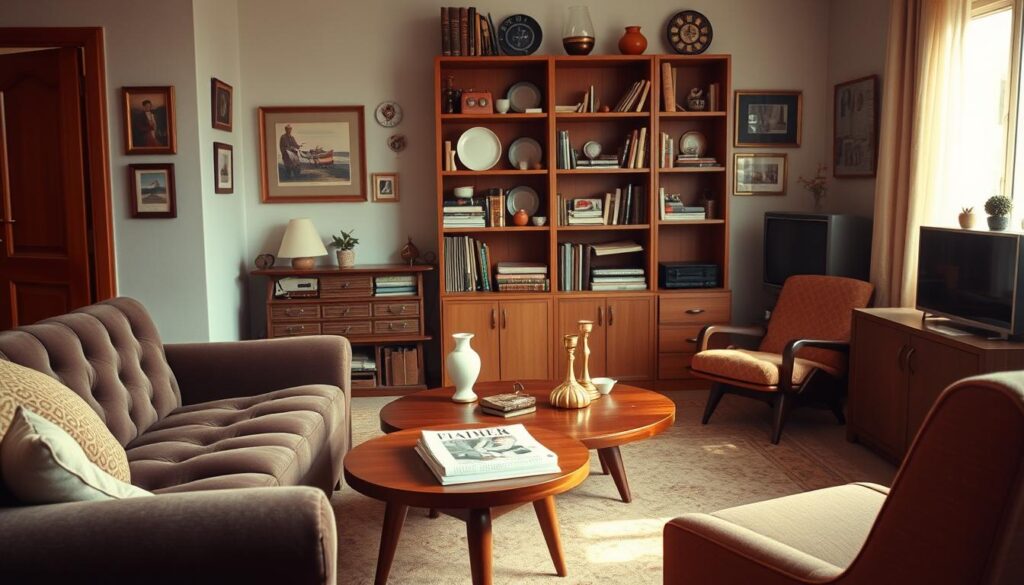
Vintage textiles, like abstract or floral designs, were also big. They were used for furniture, curtains, and more. To get a 1950s vibe, add vintage or vintage-style wallpaper and textiles to your space.
The Use of Artwork and Accessories
Art and accessories were used to make 1950s rooms unique. Abstract art and pop art were favorites, showing the era’s modern spirit. Accessories like vintage figurines and retro clocks added charm.
- Use vintage or vintage-inspired artwork to add a touch of authenticity.
- Incorporate retro-themed accessories to enhance the overall aesthetic.
- Mix and match different textures and patterns to create visual interest.
Lighting Fixtures: Iconic Designs
1950s lighting was both functional and decorative. Sputnik chandeliers and globe pendant lights were hits for their futuristic look. They used materials like metal, glass, and plastic for a cool look.
“The right lighting can transform a room, making it feel more welcoming and stylish.” – Interior Design Expert
To get the 1950s look, add these iconic lights to your decor. Choose vintage or modern versions. The right lighting can really bring the retro vibe to life.
Outdoor Spaces in the 1950s
As the 1950s began, outdoor living became a big part of American life. Suburban homes started to have lively patio spaces. With more free time after the war, people wanted to make their homes welcoming outdoors.
The Patio Movement and Outdoor Living
The patio movement was key in 1950s outdoor design. Patios were like extra rooms for dining, fun, and chilling out. People used different elements to make their outdoor spaces both useful and stylish.
- Use of durable materials like concrete, brick, and wood for patio construction
- Incorporation of outdoor heating and lighting to extend the usability of patios
- Integration of natural elements, such as plants and water features, to enhance ambiance
Popular Landscaping Trends
Landscaping in the 1950s mixed modern touches with nature. People chose:
- Lush lawns and neat hedges
- Colorful flower beds and ornamental gardens
- Trees and shrubs for shade and texture
These choices made outdoor spaces look good and work well.
Furniture for Enjoying the Outdoors
Outdoor furniture in the 1950s was both useful and trendy. It showed the era’s love for modern looks. Some popular items were:
- Eames-inspired lounge chairs and sofas
- Wicker and metal furniture with bright cushions
- Outdoor dining sets with umbrella tables
These pieces were made to last, using materials that could handle the weather.
By following the patio trend, popular landscaping, and cool outdoor furniture, 1950s homeowners made spaces that were welcoming and showed off the era’s design.
Incorporating 1950s Style into Modern Homes
To add a 1950s vibe to your home, mix old and new. This way, you celebrate the past and enjoy today’s style.
Blending Retro with Contemporary Design
Making old and new styles work together is a big challenge. Start by picking a few key pieces from the 1950s, like a vintage armchair or a classic sideboard. Then, add them to your modern decor.
For example, a mid-century modern sofa with a vintage coffee table makes a great living room. The trick is to mix the old and new in a way that looks good and feels right.
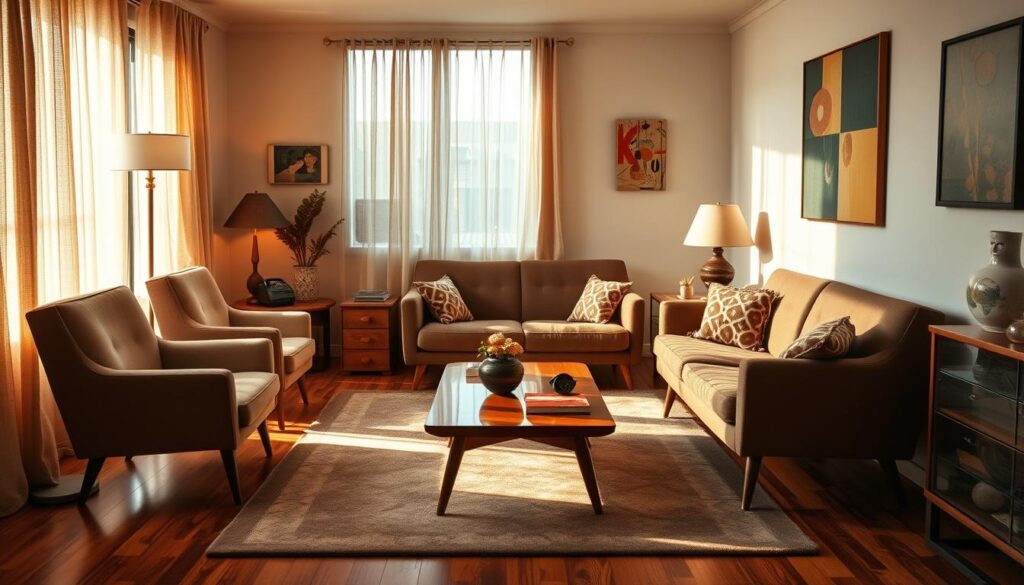
Selecting Key Pieces for Authenticity
To keep your home true to the 1950s, choose iconic furniture and decor from that time. Look for items with clean lines, organic shapes, and bold colors. These were hallmarks of mid-century modern design.
- Eames Lounge Chair
- Tulip Table by Eero Saarinen
- Vintage Textiles with Geometric Patterns
DIY Ideas for Retro Décor
You don’t have to spend a lot to add a 1950s feel to your home. Try DIY projects that bring a touch of the past. For instance, you can fix up old items, make vintage-style wall art, or paint old furniture in bold colors.
Some ideas include:
- Upcycling old lamps with new shades
- Creating a gallery wall with vintage prints
- Restoring vintage window frames for use as decorative pieces
Preserving the Charm of 1950s Interiors Today
If you own a 1950s home or are restoring one, keeping its original charm is key. We can do this by adding nostalgic home decor, like vintage decor and atomic age style, to our designs.
Restoration Tips
To keep the original design intact, we suggest using traditional materials and methods. This means restoring original fixtures, like lighting and hardware, and choosing vintage-inspired finishes.
Finding Authentic Pieces
To add real authenticity to your 1950s home, look for vintage decor at antique stores, estate sales, and online. Seek out iconic items, such as Eames chairs and Knoll sofas, to create a unified retro look.
Resources for Enthusiasts
For those wanting to bring 1950s style into their home, check out online forums, design blogs, and social media focused on vintage decor and atomic age style. These resources offer great inspiration and help in keeping the charm of 1950s interiors alive.

